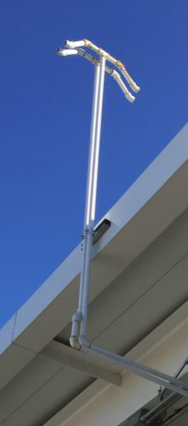Venting
Hydrogen storage facilities should be equipped with venting systems for both normal operating requirements and emergency situations. Vent lines for hydrogen (including pressure relief lines and boil-off from cryogenic systems) should be routed to a safe outside location. Vent lines are also used to dispose of hydrogen purged from the system for maintenance. The vent should be designed to prevent moisture or ice from accumulating in the line.
The vent system should:
- be leak tight
- be designed to avoid air intrusion (e.g. be purged with nitrogen) or be designed to handle the possibility of an explosion inside the piping that can reach pressures as high as 1000 kPa (145 psi)
- be unobstructed and protected from the weather
- safely release the unused hydrogen above the facility roof or at a remote location
- be designed to carry high flows during pressure relieving events
NFPA 2 Hydrogen Technologies provides the following guidance:
- Vent system designed in accordance with CGA G-5.5 Hydrogen Vent Systems
- Discharge at a height of 3.0 m (~10 ft) above grade; 0.6 m (~2 ft) above adjacent equipment; and 1.5 m (~5 ft) above rooftops
- Discharge located outdoors and away from personnel areas, ignition sources, air intakes, building openings, and overhangs.
Large quantities of unused hydrogen should be flared. According to NASA guidelines, flaring may be considered for hydrogen vent rates greater than 0.2 kg/s (~0.44 lb/s). Flare systems must have:
- pilot ignition
- flameout warning systems
- a means to purge the vent line
References
CGA G-5.5 Standard for Hydrogen Vent Systems
G-095 ANSI/AIAA Guide to Safety of Hydrogen and Hydrogen Systems
Pacific Northwest National Laboratory



